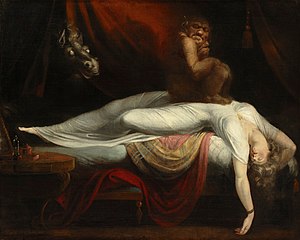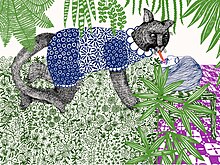Mare (folklore)
This article needs additional citations for verification. (January 2014) |

A mare (
Etymology
The word mare comes (through
Most scholars trace the word back to the
In Norwegian and Danish, the words for 'nightmare' are mareritt and mareridt respectively, which can be directly translated as 'mare-ride'. The Icelandic word martröð has the same meaning (-tröð from the verb troða, 'trample', 'stamp on', related to tread), whereas the Swedish mardröm translates as 'mare-dream'.
Beliefs
The mare was believed to ride horses, which left them exhausted and covered in sweat by the morning. She could also entangle the hair of the sleeping man or beast, resulting in "marelocks", called marflätor ('mare-braids') or martovor ('mare-tangles') in Swedish or marefletter and marefloker in Norwegian. The belief probably originated as an explanation to the Polish plait phenomenon, a hair disease.
Even trees were thought to be ridden by the mare, resulting in branches being entangled. The undersized, twisted pine-trees growing on coastal rocks and on wet grounds are known in Sweden as martallar ('mare-pines') or in German as Alptraum-Kiefer ('nightmare pine').
According to Paul Devereux, mares included witches who took on the form of animals when their spirits went out and about while they were in trance (see the Icelandic example of Geirrid, below). These included animals such as frogs, cats, horses, hares, dogs, oxen, birds and often bees and wasps.[8]
By region
The mare is attested as early as in the Norse
According to the Vatnsdæla saga, Thorkel Silver (Þorkell Silfri) has a dream about riding a red horse that barely touched ground, which he interpreted as a positive omen, but his wife disagreed, explaining that a mare signified a man's fetch (fylgja), and that the red color boded bloodiness. This association of the nightmare with fetch is thought to be of late origin, an interpolation in the text dating to circa 1300, with the text exhibiting a "confounding of the words marr and mara."[14]
Another possible example is the account in the Eyrbyggja saga of the sorceress Geirrid accused of assuming the shape of a "night-rider" or "ride-by-night" (marlíðendr or kveldriða) and causing serious trampling bruises on Gunnlaug Thorbjornsson. The marlíðendr mentioned here has been equated to the mara by commentators.[15][16][17]
Germany
In Germany, they were known as Mara, Mahr, or Mare.
German Folklorist Franz Felix Adalbert Kuhn records a Westphalian charm or prayer used to ward off mares, from Wilhelmsburg near Paderborn:
Such charms are preceded by the example of the Münchener Nachtsegen of the fourteenth century (See Elf under §Medieval and early modern German texts). Its texts demonstrates that certainly by the Late Middle Ages, the distinction between the Mare, the Alp, and the Trute (Drude) was being blurred, the Mare being described as the Alp's mother.[22]
Slavic
Poland

Etymologically, Polish zmora/mara is connected to Mara/
Protection practices included:
- drinking coffee before sleeping,
- taking the mare's hat,
- throwing a piece of a noose at the demon,
- sleeping with a leather, wedding belt or a scythe,
- inviting the mare for breakfast,[25]
- changing one's sleeping position,
- smearing feces on the front door,
- leaving a bundle of hay in one's bed and going to sleep in another room.
To protect livestock, some people hung mirrors over the manger (to scare the mare with its own face) or affixed dead
Other
A
In the northwest and south Russian traditions, the mara is a female character, similar to kikimora. Usually invisible, it can take the form of a black woman with long shaggy hair, which she combs, sitting on a yarn.[clarification needed]
In Croatian, mora refers to a 'nightmare'. Mora or Mara is one of the spirits from ancient Slav mythology, a dark one who becomes a beautiful woman to visit men in their dreams, torturing them with desire before killing them. In Serbia, a mare is called mora, or noćnik/noćnica ('night creature', masculine and feminine respectively).[29] In Romania they were known as Moroi.
Some believe that a mora enters the room through the keyhole, sits on the chest of the sleeper and tries to strangle them (hence moriti, 'to torture', 'to bother', 'to strangle', umoriti, 'to tire', 'to kill', umor, 'tiredness' and umoran, 'tired'). To repel moras, children are advised to look at the window or to turn the pillow and make the sign of the cross on it (prekrstiti jastuk); in the early 19th century, Vuk Karadžić mentions that people would repel moras by leaving a broom upside down behind their doors, or putting their belt on top of their sheets, or saying an elaborate prayer poem before they go to sleep.[30]
See also
- Alp (folklore)
- Basty
- Batibat
- Enchanted Moura
- Ghosts in Thai culture
- Incubus
- Lietuvēns
- Madam Koi Koi
- Mara (demon)
- Mara (Hindu goddess)
- Marzanna(Slavic goddess of death and winter)
- Maya (illusion)
- Moroi
- Moros
- Mouros
- Night hag
- Nightmare
- Pesanta
- Sleep paralysis, medical term for the condition the mare is thought to originate from.
- Slavic fairies
- Succubus
Fiction:
- Paranormal Entity, a 2009 found-footage film featuring a mare named Maron as the antagonist
- Marianne, a 2011 Swedish horror film featuring mares
- Borgman, a 2013 Dutch thriller film featuring mares
- Outlast, a 2013 video game featuring Mares/Alps
- Hilda, a 2018 TV series. Episode 6 "The Nightmare Spirit" focuses on one
- Mara, a 2018 American horror film
- Phasmophobia, a 2020 video game featuring Mares
Notes
- ^ a b Bjorvand and Lindeman (2007), pp. 719–720.
- .
- ^ Julius Pokorny, Indogermanisches etymologisches Wörterbuch. 2 vols. Bern: Francke, 1959. s.v. 5. mer-.
- ^ Jan de Vries. Altnordisches etymologisches Wörterbuch. Leiden: Brill, 1961. s.vv. mara, mǫrn.
- ^ C. Lecouteux, 'Mara–Ephialtes–Incubus: Le couchemar chez les peuples germaniques.' Études germaniques 42: 1–24 (pp. 4–5).
- ^ "mer- Archived 2005-09-10 at the Wayback Machine" in Pickett et al. (2000). Retrieved on 2008-11-22.
- ^ Pócs 1999, p. 32
- ^ a b Devereux (2001), Haunted Land, p.78
- Perseus Project.
- ISBN 5-85270-032-0.
- ^ Ynglinga saga, chapter 13 (and quoted stanza from Ynglingatal), in Hødnebø and Magerøy (1979), p. 12
- ISBN 978-0292786967.
- ^ Siida – Staalon ja maahisten maa – Kertojien perilliset (in Finnish)
- ISBN 978-1107620223.
- ^ Morris, William; Magnússon, Eiríkr (1892), The Story of the Ere-dwellers (Eyrbyggja Saga), B. Quaritch, pp. 29–, 274, 348
- S2CID 11662165
- S2CID 162338244
- ^ Kuhn, Adalbert (1864). "Indische und germanische Segenssprüche". Zeitschrift für Vergleichende Sprachforschung. 13: 12.
- ^ Last line supplied from "541. Mahrsegen" Kuhn 1859, vol. 2, p.191
- JSTOR 30169065.
- ^ Last line of translation supplied by Ashliman, D. L. "Night-Mares". Folklore and Mythology Electronic Texts. Retrieved 23 May 2013.
- ISBN 978-1843832942.
- ^ OCLC 751748759.
- ^ Kolberg, Oskar (1865). The People. Their Customs, Way of Life, Language... Poland.
{{cite book}}: CS1 maint: location missing publisher (link) - ^ Gołębiowski, Łukasz (1884). Lud polski, jego zwyczaje, zabobony... Poland.
{{cite book}}: CS1 maint: location missing publisher (link) - ^ Grimm 1883, TM 2, 464, note2
- ^ Bernard Sychta. Słownik gwar kaszubskich na tle kultury ludowej, Ossolineum, Wrocław - Warszawa - Kraków 1969, tom III, pp. 102-105
- ^ "Slovenské slovníky". slovnik.juls.savba.sk. Retrieved 2021-02-06.
- ^ Pócs 1999, p. 33 gives the feminine form.
- ISBN 9789639116184
General references
- Bjordvand, Harald and Lindeman, Fredrik Otto (2007). Våre arveord. Novus. ISBN 978-82-7099-467-0.
- Devereux, Paul (2001). Haunted Land: Investigations into Ancient Mysteries and Modern Day Phenomena, Piatkus Publishers.[unreliable source?]
- Grimm, Jacob (1883), "XVII. Wights and Elves", Teutonic Mythology, vol. 2, James Steven Stallybrass (tr.), W. Swan Sonnenschein & Allen, pp. 439–517
- Hødnebø, Finn and Magerøy, Hallvard (eds.) (1979). Snorres kongesagaer 1, 2nd ed. Gyldendal Norsk Forlag. ISBN 82-05-22184-7.
- Kuhn, Adalbert (1859). Sagen, Gebräuche und Märchen aus Westfalen und einigen andern, besonders den angrenzenden Gegenden Norddeutschlands. Brockhaus. pp. 18–22, 191.
- Pickett, Joseph P. et al. (eds.) (2000). The American Heritage Dictionary of the English Language, 4th ed. Boston: Houghton Mifflin. ISBN 0-395-82517-2.
- ISBN 978-9639116184.
Further reading
- Barešin, Sandra (2013). "Mora kao nadnaravno biće tradicijske kulture" [Mare as Supernatural Being of Traditional Culture]. Ethnologica Dalmatica. 20: 39–68.
- Batten, Caroline R. (2021). "Dark Riders: Disease, Sexual Violence, and Gender Performance in the Old English Mære and Old Norse Mara". The Journal of English and Germanic Philology. 120 (3): 352–80. S2CID 236779356.
- Pieńczak, Agnieszka; Povetkina, Polina (2023). "The Polish Nightmare Being (Zmora) and the Problem with Defining the Category of Supernatural Double-Souled Beings". Folklore. 134 (1): 73–90. .

